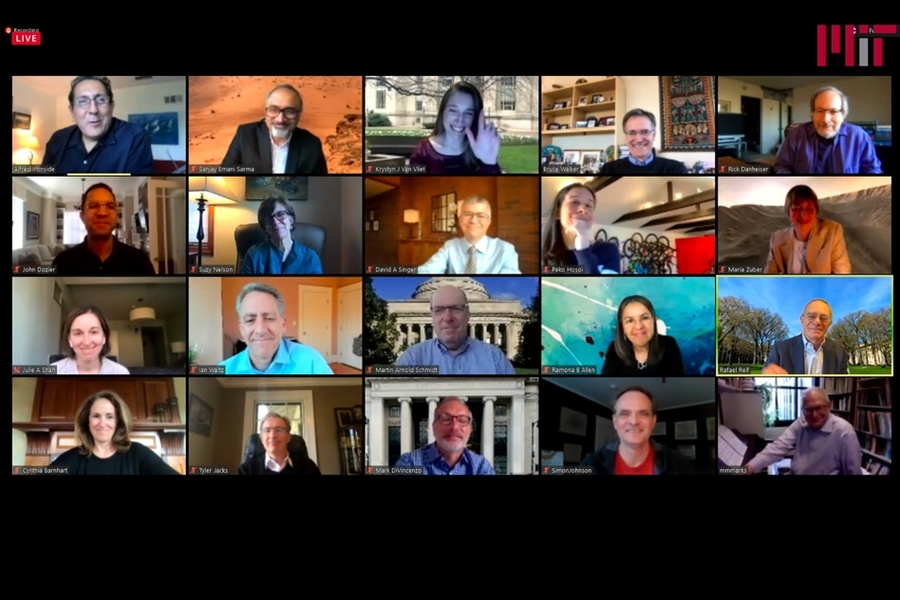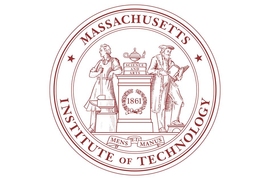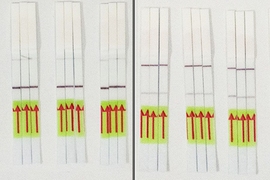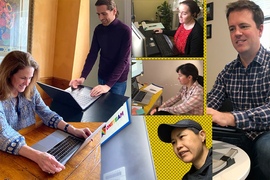Although many are eager to find out what MIT’s plans will be for reopening the campus, President L. Rafael Reif said Tuesday that those decisions should wait until more information is available about the Covid-19 virus and the effectiveness of various countermeasures or treatments. Speaking at the Institute’s second online “town hall,” he noted that those decisions will likely be announced by late June or early July.
Whenever people do return to campus, it will almost certainly be a gradual, staged process, Reif and others suggested during the 90-minute virtual event, which featured 20 top MIT administrators and faculty, and included an extended Q&A session to address questions submitted by viewers. The panel detailed the efforts underway by several committees that are examining different aspects of developing contingency plans for the reopening process.
Now that the campus has been closed for about eight weeks, Tuesday’s virtual community gathering was intended to give some insight into the decision-making process and the factors that are being weighed, Reif said. At the top of the list is figuring out how and when to reopen. Among the factors that will guide those decisions is “the state of the public health situation and the state of medical science,” he added.
Medical factors
Bruce Walker, head of the Ragon Institute of MGH, MIT and Harvard and professor of the practice at MIT, discussed some of the medical information that will inform the planning process. “There’s an experiment going on right now across the country,” he said, that will help to inform those decisions, at places including Mass General Hospital, where he works. “The reality is that using personal protective equipment and monitoring for symptoms has resulted in health care workers actually being able to be safe,” he said. “The problems for health care workers have come when they didn’t have masks to use” and when they haven’t had the additional protective equipment needed for particular procedures.
The data now suggest, he said, “if you wear a mask, and everyone else wears a mask, the chances of transmission drop dramatically.” Adding frequent temperature monitoring lowers those chances even more. So that suggests that use of masks, physical distancing, and symptom and temperature monitoring will have a dramatic impact on transmissibility, he said.
New information may become available over the next month or two that could help in terms of informing the decisions about reopening, he said: “The first of these is surveys to understand just how many people have been infected,” and thus how close the population may be to “herd immunity,” the point when enough people have already been exposed so that ongoing transmission dwindles. “That will be important information for us to understand.”
In addition, once tests become widely available, it will become feasible to test the entire MIT community. And ultimately, a key step will be the development of a “high-throughput, saliva-based test for presence of the virus itself.” He cited a webinar that he and others held last week about advances that give hope that such a rapid, simple home-based test may become available at some point, so that people could test themselves every morning as easily as brushing their teeth.
Repopulating the campus
Suzy Nelson, vice president and dean for student life, said that MIT has about 2,000 people in residence on campus now: 1,300 graduate students, 200 undergraduates, and about 500 partners, spouses, and children. Looking ahead to the fall, there are still more questions than answers, she said, and she asked for students to take part in helping to figure out that process.
First of all, they can respond to surveys that have been sent to them, asking about their experience during this period of physical isolation. Second, she asked them to look at a problem statement that has been posted online, titled “We solve for fall,” and offer their suggestions. She also asked them to join one of two smaller town hall meetings for students that are being planned.
“How can we look at this in a creative way,” she asked, “and reimagine the MIT campus in a way that’s positive and special and as personally engaging as we want it to be?” At the same time, in making these decisions, “How can we be sure we prioritize community health and well-being for all who are here on campus?”
David Singer, professor and head of the Department of Political Science, who is a head of house in the undergraduate student residence MacGregor House, said that he expects creative solutions to emerge from student discussions. “This is MIT, so the outcome will be new traditions, and hopefully clever strategies that no one has thought of before, and importantly some continuity in some of the core aspects of residential life that make MIT a special place to live and to study.”
Julie Shah, associate professor of aeronautics and astronautics and head of house in the graduate residence Sidney Pacific, said that students there have maintained a variety of group online activities to help maintain their sense of community even under physical separation. They have been working together to address questions such as how to manage the use of common spaces such as kitchens and lounges, and have also teamed up to work on projects such as developing mobile apps for alerting residents to potential Covid-19 exposure while maintaining privacy considerations.
Academic continuity
Ian Waitz, vice chancellor for undergraduate and graduate education, said that in anticipating how things will be on campus as people return, there will likely be situations where, because of actual exposure or particular vulnerability, some professors may not be able to be on campus while their students are, and vice versa. There will remain a need for two-way remote interaction capability for much of the curriculum. “That’s a heavy lift,” he said, “but we’re preparing to do that.”
The big question on everyone’s mind, he said, is “what will the fall look like, in terms of how much online education will we have, and how much in-person education will we have, and what does it mean to be socially distanced in our instructional spaces and labs and project spaces and classrooms?” Because things are changing so rapidly, he said, one of the best things they can do is to “plan for multiple different scenarios very vigorously, and prepare for those, but wait to make decisions until we learn more.”
In that light, plans are being made for “everything from having a fully online fall, to having all the students back, to things that are in between,” such as half the students for half the time. As an optimist at heart, he said, he is hopeful that “we’ll have at least some students back in the fall,” but that will be constrained by social distancing, testing, and other considerations.
Rick Danheiser, the chair of the faculty and the Arthur C. Cope Professor of Chemistry, said that he has been leading a group called APART, the Academic Policy and Regulations Team, which includes faculty and students, in working out adaptations to academic regulations that will apply in the fall term. He said their guiding principles are to develop policies that promote an educational experience for all students that is “as full, as enriching, and as rewarding as possible,” while also being sensitive to the fact that individuals may be going through significant challenges and obstacles. The group plans to release its initial recommendations within the next week.
Peko Hosoi, associate dean of the School of Engineering and the Neil and Jane Pappalardo Professor of Mechanical Engineering, added that the faculty and students’ resilience and responses to the situation so far have been “really remarkable, and that actually fills me with a lot of optimism for the fall.” She added that historically, MIT has been at its best when stepping up to act in service of the nation and the world to address the needs that were paramount at a given time, as is happening today.
Research and space on campus
Krystyn Van Vliet, associate provost and professor of materials science and engineering, is leading a team looking at the use of space on campus, and said that “what is already clear is that there will be a lower density in any given space.” That involves figuring out policies for not just classrooms and lecture halls but also project workspaces, labs, and other spaces.
“What will the classroom of the future, when we bring students back to campus, look like?” she asked. “This is a puzzle, and we enjoy solving puzzles at MIT.” The key, she added, will be maintaining the well-being of students, faculty, and staff.
Regarding plans for ramping-up research activities on campus, Vice President for Research Maria Zuber said that planning involves a phased resumption of work and efforts to assure continuity of funding for research projects.
Zuber has been meeting with heads of 20 labs and centers to get input on the factors that should be weighed in deciding which facilities to reopen when. They developed a set of guidelines which have been distributed for comment, and Professor Tyler Jacks is chairing a group that will continue to develop that process.
Jacks, the David H. Koch Professor of Biology, said that some research has been ongoing on campus, much of it directed specifically at Covid-19. But when it comes to bringing back other research, he said the committee recognizes that there will be some people who cannot, or choose not to, come back for a variety of reasons. “It would be voluntary,” he said. “We are all anxious to get back to research, but we have to do it in a fashion that represents the safest practices.”
That will include a low-density work environment, use of personal protective equipment, and daily health checks, and will likely require shift-work schedules to space out occupancy over time. “Over time, as conditions allow, we envision future phases that allow more individuals on campus at a given time,” he said.
Working from home
Those of MIT’s staff of around 10,000 people who are currently doing their jobs from home are coping well, said Ramona Allen, vice president for human resources. “They’ve done extraordinary things over the past several weeks.” But like everyone else, they are eager to come back to campus, she said.
When people return to campus, she said, it will probably be in a phased way, and some people who are eager to return, especially those in administrative roles, may not be among the first categories called back. “People have to be patient with that.”
John Dozier, the Institute Community and Equity Officer, said he will be conducting a survey for all MIT students, faculty, and staff to help decide how best to target resources. He is leading a community continuity group aimed at addressing concerns about keeping support systems in place even while physically separated. “The sense of connection, belonging, and inclusion is vital,” he said.
Hundreds of people submitted questions to panel online, and Vice President for Communication Alfred Ironside said the most frequently asked questions had to do with whether there would be any changes to tuition rates in the fall, and whether there would be continuity in graduate student support.
Provost Martin Schmidt said that tuition and fees are normally announced in the spring, as they were this year. “But these are clearly not normal times,” he said, and until decisions are made about exactly what form the fall will take, it’s too soon to say if there will be any impact on tuition. But it is expected that students’ financial needs will go up, as it has during previous crises. Meanwhile, for graduate students, stipends are continuing and will increase slightly, and health insurance rates will not increase for the next year, he said.
Several participants asked about how MIT will ensure the safety of both students and staff when people do return to campus, and whether face masks will be needed and will make a difference. Reif said that if the decision on whether to require face masks were made today, the answer would be yes, and “we’re planning along those lines.”
Walker agreed, saying “face masks are critical. There’s every reason to believe that coming back to campus is going to be associated with everyone wearing face masks.”
Asked about whether MIT might have to resort to layoffs, Allen replied that “layoffs are a last resort, always. None of us wants to go through that.” She said the leadership at MIT understands what a tough time this would be to lose a job. “The goal is to avoid that at all costs.”
In response to questions about when the decision will be made about reopening the campus to students, faculty, and staff, Reif said “this is a pretty serious question that we are thinking about on a daily basis,” and noted that he is relying heavily on experts including some of those represented on the town hall panel. But in making the decision, he would like to wait as long as possible as more information emerges about this rapidly unfolding situation.
But even if things are still changing, he said he doubted that MIT would wait more than eight weeks to reach a conclusion. By late June or early July, he said, “we should know enough to try to make the right decision for the campus.”



![Kyle Filipe working from home. "Our mentality is: keep telling us what you need and we'll keep trying to figure out creative solutions. That’s what [MIT IS&T] did before Covid-19 and that’s what we’ll do long after Covid-19.”](/sites/default/files/styles/news_article__archive/public/images/202005/kyle-filipe-information-services-and-technology.jpg?itok=Bnt3iuE7)







